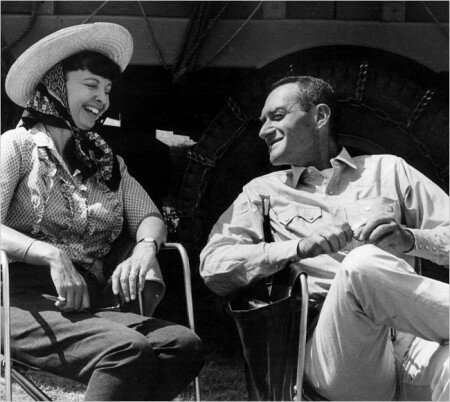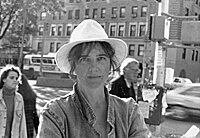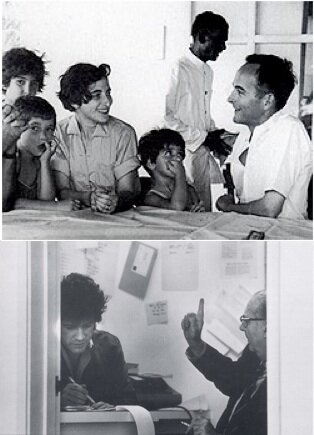
James Ivory listens to screenwriter Ruth Prawer Jhabvala in New Dehli (above)/James Blue listens to director Roberto Rossellini in Houston (below)
On Oct. 10 at 7:00 PM, three time Oscar nominee James Ivory comes to Portland to introduce MAURICE (1987), starring James Wilby, Hugh Grant and Rupert Graves. Handpicked by Ivory for the Hollywood event, MAURICE is on the short list of films for which he served as both screenwriter (with Kit Hesketh-Harvey) and director.
James Ivory grew up in Klamath Falls and graduated from the University of Oregon in 1951. Famously well traveled, he lives in New York and London, and does not often visit Portland. He’s coming this time to see an extremely rare film, and to help celebrate the life and career of its director, James Blue, who was Oregon’s first Oscar nominated director, and Ivory’s UO classmate.
On Oct. 11 at 1:00 PM, Richard Blue, the brother of James Blue, will introduce James Blue’s THE OLIVE TREES OF JUSTICE, winner of the Critics Prize at Cannes in 1962.
James Blue grew up in Portland and graduated from the University of Oregon in 1953. James Ivory remembers working with him building sets for a college drama production. Did they have any idea they would become Oregon’s first Oscar nominated directors?
And that they both would launch careers from outside this country?
I learned about James Blue directly from James Ivory in 2009. Since that time, it has become easier for Oregonians to learn about this forgotten Oregon artist. Thanks to the James and Richard Blue Foundation, James Blue’s papers have joined James Ivory’s as part of the University of Oregon’s Special Collections in the Knight Library.
But who was James Blue?
On Oct. 11 at 2:30 PM, following the screening of THE OLIVE TREES OF JUSTICE, there will be a panel discussion titled James Blue, a life in conversation.
Using archival photos from the Blue Collection to structure the narrative, three panelists will retrace his life from Tulsa to Portland to Eugene to Paris, then on to his professional breakthrough in Algiers, where he made THE OLIVE TREES OF JUSTICE, his subsequent embrace of documentary, and his dual identity as filmmaker and educator.
The panelists are:
Richard Blue, the brother of James Blue
James Dormeyer, Blue’s classmate at L’Institut des hautes études cinématographiques in Paris and a close friend
Gill Dennis, the screenwriter of Blue’s 1969 Oscar nominated doc, A FEW NOTES ON OUR FOOD PROBLEM, and a close friend.
Earlier on Oct. 11, at 11:00 AM at the Hollywood, we will screen James Ivory’s AUTOBIOGRAPHY OF A PRINCESS (1977), starring Madhur Jaffrey and James Mason. Ivory chose AUTOBIOGRAPHY specifically to complement THE OLIVE TREES OF JUSTICE, which shares its theme of post colonial identity crisis.
Tickets can be purchased online at hollywoodtheatre.org.
The Mid Century Oregon Genius screening of THE OLIVE TREES OF JUSTICE is co-sponsored by The James and Richard Blue Foundation.
Here’s more information about the Mid Century Oregon Genius screening series.
Fiscally sponsored by the Oregon Cultural Heritage Commission, the Mid Century Oregon Genius screening series is funded by grants from Kinsman Foundation and Miller Foundation.
More information about the parallel career tracks of these two Oscar nominated directors can be found here.
Tags:
April 24th, 2014 by Anne Richardson · Uncategorized
I took Oregon Movies, A to Z down today.
Yesterday I attended the mini-ceremony welcoming James Blue’s papers and films to the University of Oregon’s Knight Library.
When I started Oregon Movies, A to Z, I was alarmed that no one was paying attention to Oregon’s film history. I no longer have that feeling. James Fox, the head of Special Collections at Knight Library, has collected the papers of three Oregonians who made significant contributions to American film history: James Ivory, Ken Kesey and James Blue. The Cinema Studies department faculty were present and fully engaged in celebrating the acquisition of James Blue’s papers and films.
I am very pleased to see the progress I sought take place. Oregon Movies, A to Z is no longer needed.
I will continue advocating for support for Oregon film history scholarship. I want to see one of the Oregon University System schools choose to develop a specialty in animation studies, including animation history, and for that school to begin a scholarly collection of books on that subject. It is not possible today to research Oregon’s animation history with the teachers and the library resources we currently possess. I am interested in changing this.
If we have world class artists, we should have world class scholars.
Speaking of which, thank you to the people who wrote in with information which helped deepen my understanding of Oregon film history!
AR
Tags:
February 17th, 2014 by Anne Richardson · Handy guide series
Tags: Harriet Frank Jr·Irving Ravetch
February 12th, 2014 by Anne Richardson · Handy guide series
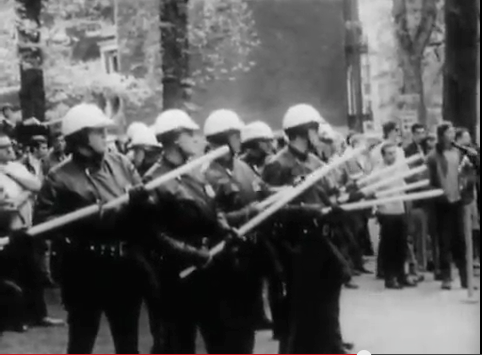
Police face off against antiwar demonstrators in The Seventh Day, a 1970 documentary shot by Portland State University students.
A long list of American filmmakers have chosen The City as a subject in documentaries, educational films, and narrative features. The following list is of films about The City which have an Oregon connection.
This list includes both fiction and non-fiction films. It is NOT comprehensive!
The Boy Mayor 1914, directed by Henry McRae. Starring teenager Eugene J. Rich, Portland’s real Boy Mayor. The fictional plot line depicts the “clean up the streets” motive behind the Boy Mayor campaign. Restored by National Film Preservation Foundation, thanks to Michele Kribs, Oregon Historical Society’s film archivist. Shot in Los Angeles.
Dementia 1953, retitled Daughter of Horror 1955, directed by John Parker, Jr. The City is a moody, expressionist dreamscape in this combination art film/horror film made by the son of Portland theater chain owner, J. J. Parker. Score by George Antheil. Shot in Los Angeles.
Portland Expose 1957, directed by Harold Schuster. Exploitation film, based on real events. The plot line had to be fictionalized so it could be believed. In real life, it was a well known crime boss, not an upstanding small businessman, who blew the whistle on the corrupt union leader who was muscling in on his vice world territory. Shot in Portland.
The Olive Trees Of Justice 1962, directed by James Blue. Banks of barbed wire surround buildings, police are everywhere, bombs go off, tanks roll by, and yet somehow everyday life still goes on. A young French colonialist tries to locate his childhood friends, and his own identity, in the middle of the chaos. Shot in Algiers.
The Seventh Day 1970, directed by students at PSU’s Center For The Moving Image. Documentary coverage of an anti-war demonstration which erupts into violence. Made by Tjeck Dusseldorp, with Charles Auch and future music video superstar Jim Blashfield. Shot in Portland.
We Are The City 1972, directed by Tom Chamberlin. Portland is never named in this educational film, made for Encyclopedia Britannica. Includes Mayor Terry Shrunk and Neil Goldschimdt (another Boy Mayor, but at that time still a City Councilman). The footage is 95% Portland.
The Case Of The Kitchen Killer 1976, directed by Tim Smith. Self taught 16mm filmmaker’s black comedy uses Portland locations sensitively. Smith was just out of high school when he made this film. The hand of crew member Matt Groening makes a cameo appearance holding a murder weapon. Ben Padrow provides the voice over narration. Shot in Portland.
Who Killed The Fourth Ward? (1976-77) and The Invisible City: Houston Housing Crisis (1978-79), directed by James Blue. Oregon’s first Oscar nominee focused on urban housing conditions for his two longest docs, made for Houston public television. Shot in Houston.
Property 1978, directed by Penny Allen. Eight Portland friends respond to gentrification by deciding to band together to buy a house in their Lair Hill neighborhood. Not a documentary, but inspired by real life events, with some of the participants in the real events joining the cast, playing themselves. Cinematography by Eric Ericson, sound by Gus Van Sant. Shot in Portland.
Talk Radio 1988, directed by Oliver Stone. Based on a play written by Portland artist Tad Savinar and New York actor Eric Bogosian. The play is about urban discontent, but the real reason this film is on this list is that Tad Savinar became one of Portland’s most important urban planners. Shot in Dallas.
Drugstore Cowboy 1989, directed by Gus Van Sant. The fictionalized memoir of a real life felon provides a portrait of a city. Shot as a period piece, set in the 1970’s. Starring Matt Dillon, Kelly Lynch and William Burroughs. Van Sant’s ascension to stardom branded Portland as an indie capital. Shot in Portland.
Alien Boy 2012, directed by Brian Lindstrom. Documentary examining the death of James Chasse, Jr., a man with severe and persistent mental illness who was arrested for running away from Portland police, and who died in their custody. Shot in Portland.
Tags: Brian Lindstrom·Charles Auch·Eric Bogosian·Eric Ericson·Eugene J. RIch·Gus Van Sant·Harold Schuster·Henry McRae·James Blue·James Chasse Jr·Jim Blashfield·Kelly Lynch·Matt Dillon·Matt Groening·Michele Kribs·Neil Goldschimdt·Oliver Stone·Penny Allen·Tad Savinar·Terry Shrunk·Tim Smith·Tjeck Dusseldorp·Tom Chamberlin·William Burroughs
How deep are the Portland roots of Portlandia?
Recognizing that the question deserves a book length examination, I took the first step elsewhere on the internet.
Here’s a excerpt, about Toni and Candace:

Who needs books? They have each other. They are Adam and Eve. Laurel and Hardy. Akbar and Jeff.
Read the rest …
Tags: Carrie Brownstein·David Cress·Fred Armisen·Robert Johnston

Irene Bedard, as Indian Jenny
Who was it that said a movie only needs three good scenes?
Paul Newman experimented with that formula in 1970 by making a film with only one. In Sometimes A Great Notion, Richard Jaeckel played the trusting, loyal Joe Ben who drowns as his cousin Hank tries and fails to keep him alive. Jaeckel was Oscar nominated for a performance which culminates in that one scene, but what happened to the rest of Kesey’s masterful epic?
Where are the other two good scenes?
I am guessing they landed on the cutting room floor when actor-producer-director Paul Newman jettisoned the novel’s main plot. A second try at adapting Kesey’s sprawling masterpiece, using the multi episode format available in the television mini series, could restore the “since you slept with my mother, I am going to sleep with your wife” plot line which is central to the book.
So invested am I in the belief that Sometimes A Great Notion would make an excellent mini series that I have gone to the trouble of assembling a dream cast.
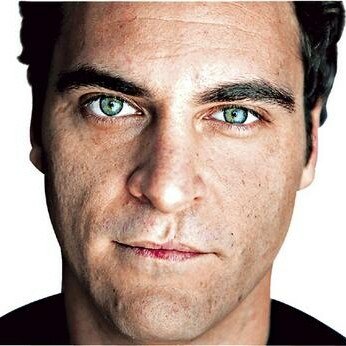
Joaquin Phoenix, as Hank Stamper
It is clear that Hank Stamper would best be played by Joaquin Phoenix. Joaquin matches Kesey’s description of Hank, down to the curly hair, muscular build and flashing green eyes. Hank has a high intelligence, a volatile temper and a secret which he keeps from everyone, including his wife, and including himself.

Greta Gerwig, as Myra Stamper
Myra, Henry Stamper’s second wife, seduced her stepson Hank on his sixteenth birthday, and slept with him throughout his high school years. She treats Hank as her lover even after she returns to the East Coast to raise Lee, Hank’s half brother, in privilege. When Myra, isolated by her transgression, commits suicide, Lee drops out of graduate school to take revenge. He goes West to seduce Hank’s wife, and ruin his life. However when he meets Viv Stamper, he falls instantly, genuinely, in love. But he still makes sure Hank witnesses him in bed with Viv just as he, Lee, as a child, had witnessed Hank in bed with Myra. Viv leaves Hank, but Lee remains behind. Alone in the bus station, waiting to get out of town, Viv sees a photo of young Myra, who she closely resembles. Viv understands for the first time that she was always, to Hank, only a substitute.
That’s the plot of Sometimes A Great Notion. There’s logging, the union, bar fights, prostitutes, and death. But the real story is three generations of sexual obsession.
The Stamper family is driven by ghosts. They are possessed by them, in bondage to them. Monstrous in their strength, their hatred and their self definition, they are shadow people in thrall to the past. The community, not incorrectly, perceives them as a threat. Lee, who was raised elsewhere, returns intending to destroy his family but instead joins them. Viv, who married into the family, and had no idea of leaving, escapes. There is no room for women in the world of the Stamper family. Kesey knew this about Viv, and described her in his notes as “just an ordinary girl, caught up in a family plot”.

Greta Gerwig, as Viv Stamper
Greta Gerwig has the range to play the dual roles of exotic, neurotic, sex abusing Myra Stamper, and the normal, ‘ordinary girl’ Viv Stamper. She has the power to play both. As Kesey wrote: “Viv is a pawn in a game, a long ago game”.
Then there’s Lee.
In Kesey’s notes for the novel he writes: “Hank the fighter, the winner. Lee the pacifist, the loser.
When Kesey wrote Sometimes A Great Notion, jocks were winners. Much of the plot concerns the courage the lanky, underdeveloped Lee must summon to continue seducing the wife of his violent, physically powerful half brother. The better Lee knows Hank, the more he realizes how dangerous his plan is.
How to cast this role?
The most important qualities Lee must have are a physical resemblance to Hank Stamper/Joaquin Phoenix, and the ability to transform from child to adult. He must be, as all Stampers are, convincingly, and passionately self deluded.

Nicholas Hoult, as Lee Stamper
When Lee chooses to remain behind with Hank, the brother he both loves and hates, we understand he has chosen death. He had his chance at life. Viv=vitality=life. As Viv watches the two men struggle to bring the logs down the river from the window of her Greyhound bus out of town, she is Ishmael escaping the unholy vortex of Moby Dick. Kesey’s understanding of Viv as a whole person, not a plot device, is entirely, but entirely, absent from the 1970 film adaptation of Sometimes A Great Notion.
So many other wonderful character parts! Ancient patriarch Henry Stamper should be played by an actor who is old, old, old enough to be a grinning defiant skeleton. Death in a hardhat. Terrifying! That’s the way Kesey wrote him. Then there’s obsequious undertaker Boney Stokes, apoplectic union man Floyd Evenwrite, ice cold bureaucrat Jonathan Draeger, and hard living, mud flat dwelling, fortune telling Indian Jenny, who spends her entire life in love with her memory of the handsome green-eyed logger, Henry Stamper, who alone among all his peers refused to patronize her services. Kesey wrote an entire world.
One appreciative reader: We have here all you could ever want to know about felling trees, bear hunting, the life and language of a small-town bar, juvenile delinquents in small-town America, music of the 50s and 60s, shamans, Indians, evangelists, Captain Marvel, small-town justice, union organizing, revenge, old age, dying, death.

Irene Bedard, as Indian Jenny
Restoring Indian Jenny to the plot would make an honest miniseries out of a Sometimes A Great Notion, and communicate both the novel’s social and psychological complexity, and its epic sweep. I propose Irene Bedard to play the beautiful small town prostitute who falls in love with the young logger Henry Stamper, and whose thwarted union with him provides the narrative engine for the rest of the plot.
It is because of Henry’s unexpressed love for Indian Jenny that he marries socialite Myra, who has Indian Jenny’s long black hair. It is because of Henry’s son Hank’s incompletely expressed, semi-incestuous love for Myra that he marries Viv, who has Myra’s face. I calculate it would take five to six one hour episodes to do justice to this multi generational chain of human frailty masquerading as strength.
I have done the casting.
Who will make Sometimes A Great Notion: The Mini Series?
Tags: Greta Gerwig·Irene Bedard·Joaquin Phoenix·Ken Kesey·Nicholas Hoult·Paul Newman·Richard Jaeckel
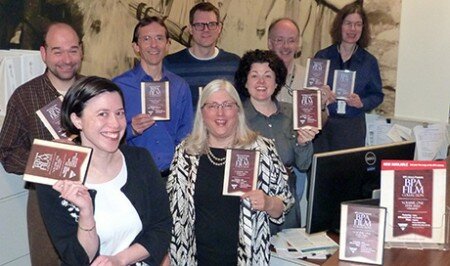
Members of the BPA chapter of the Elmer Buehler Fan Club, Libby Burke in the center.
This 2 DVD set was made for you and me!
The Friday Film Festival held by Bonneville Power Administration in March 2013 was so successful the curator of the series, research librarian Libby Burke, decided to release the films on DVD. She selected six, spanning 1939 to 1954. The first, Hydro (1939) was directed by Gunther V. Fritsch, (you know, the guy who went on to direct The Curse of the Cat People in 1945). The second, The Columbia (1949), features songs written for it by Woody Guthrie. The third, Highline (1950) focuses on long distance transmission of electricity. All three were produced by Stephen B. Kahn.
Stephen B. Kahn boasted that he discovered Woody Guthrie. He made the hire, at the recommendation of Alan Lomax, before Woody was famous. It was 1941. Kahn hired Woody to come to Portland for one month to write songs. He was assigned a driver, BPA employee Elmer Buehler, and with Woody in the back seat strumming his guitar, Elmer drove up and down the “Power Stream” as Stephen Kahn liked to call the mighty Columbia River. Woody wrote a song a day during that month. He was paid $266.
One song was Pastures of Plenty. Another was Roll On, Columbia. Both were first recorded here in Portland, at the BPA office.
During the McCarthy era, when political winds had changed, Elmer Buehler, the patron saint of Oregon film archivists, was ordered to destroy all BPA’s prints of Hydro and The Columbia. He refused to do it, and sequestered one print of each in his basement.
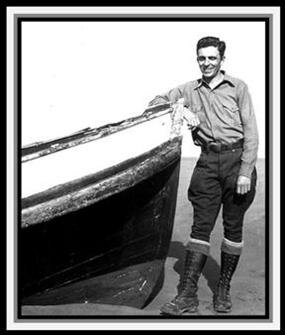
Elmer Buehler (1911 – 2010)
I propose we hold an annual Elmer Buehler Film Festival of rescued films in his honor. In the meantime, you can hear Woody Guthrie perform the songs he wrote in the back seat of Elmer’s car on The Columbia, the second film on the first DVD.
The second DVD has Power Builds Ships (1942), showcasing PNW ship building as part of the war effort. 25,000 Volts Under The Sea (1951) documents the rural electrification of the San Juan Islands. Look To The River (1954), about the construction of the McNary Dam and the Hungry Horse Dam, features a score by Ernest Gold, who hadn’t yet won his Oscar.
Taken together, the series forms a composite portrait of the river, a forceful, magnetic, photogenic presence, and of the people who spent their lives attempting to tame it. Libby Burke’s introductions provide an inside track on the personalities behind the films. These films were made during a comparatively fallow period, when it comes to indigenous Oregon filmmaking, so the interface between BPA and Hollywood is especially fascinating.
From the BPA website:
And the BPA Library is offering the newly released set to the general public, particularly to teachers, schools, libraries, Northwest electric utilities and other public institutions. To receive a copy, contact BPA’s Public Information Center at the agency’s headquarters in Portland at 503-230-4636 (toll-free: 800-622-4520) or . In addition, all six films are available to view and share on BPA’s YouTube channel.
I hereby claim all the films included in the BPA Film Collection: Volume One, 1939 – 1954, as Oregon films, based on the location of the producer, Bonneville Power Administration, in Portland.
Tags: Alan Lomax·Elmer Buehler·Ernest Gold·Gunther V. Fritsch·Libby Burke·Stephen B. Kahn·Woody Guthrie
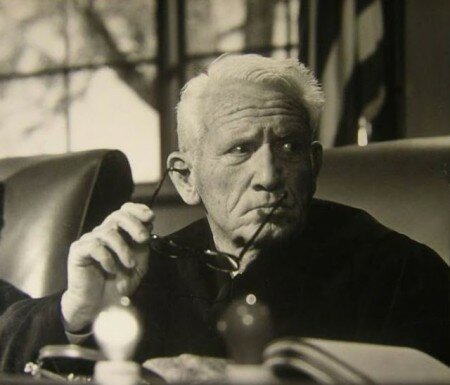
Spencer Tracy was Oscar nominated for his role as Chief Judge Dan Haywood, a fictionalized character based on James T. Brand, the Oregon judge who actually presided over the Justices Trials at Nuremberg in 1947.
James T. Brand was Associate Justice of the Supreme Court of Oregon when he was tapped to travel to post -war Germany to conduct the trial of German judges who had cooperated with the Nazi regime.
From an obituary of James T. Brand:
James Tenney Brand, 77, retired Chief Justice of the Oregon Supreme Court, died on February 28, 1964, in Phoenix, Arizona, where he and his wife were vacationing. Justice Brand was born in Oberlin, Ohio, on October 8, 1886, where his father, a Congregational minister, was Oberlin College chaplain. In 1914 he received the LL.B. degree from Harvard University, and in 1916 he married the former Irene Morley, of Cleveland.
Following early private practice Justice Brand’s life became increasingly one of public service. He was city attorney of Marshfield, Oregon. In 1927 he became circuit judge in the Second Judicial District in Oregon. In 1941 he was appointed a justice of the Oregon Supreme Court and was Chief Justice, 1951-58. As a Supreme Court judge he participated in a number of important decisions. In 1947 Willamette University awarded him the Honorary Doctor of Laws Degree.
That same year he was appointed a judge in the war crimes trials in Nuremberg, Germany, and through much of the trial period he was the presiding judge. In Oregon he was a member of a gubernatorial committee to study improvement of the State’s judicial system. He earned distinction in the fields of constitutional and international law.
Following retirement from the Oregon Supreme Court in 1918, he taught constitutional law for three years at Stetson University in Florida. He also lectured in jurisprudence for a time at the University of Oregon. He was president of the Oregon Bar Association, 1934-35, and had served as a director and president of the Coos Bay National Bank. He served both Oberlin College and Reed College as trustee. He contributed significantly to many professional journals and wrote frequently for the Portland Oregonian as an editorial columnist.
James T. Brand joins an elite group of Oregonians who have inspired characters in films.
I hereby claim Judgement At Nuremberg as an Oregon film, based on the role James T. Brand played in inspiring the character of Dan Haywood, played by Spencer Tracy.
Tags: Abby Mann·James T. Brand·Spencer Tracy·Stanley Kramer
November 15th, 2013 by Anne Richardson · News

Not all Oregon film historians are women, but this first group was. Left to right: Heather Petrocelli, Anne Richardson, Ellen Thomas, Rose Bond. Not pictured: Michele Kribs, unavailable because she was out riding her motorcycle.
Dateline: 2033, 20 years from now.
The Oregon Film History Initiative celebrated its 20th birthday today by blowing out candles on 20 virtual cakes scattered throughout the state.
Founded in 2013 by a group of librarians and historians, OFHI’s original mission was to ensure that key documents and artifacts essential to a full understanding Oregon’s unique film history were successfully archived within the state.
The Initiative began unofficially with the acquisition of James Ivory’s papers at the U of O. A trickle of film scholarship triggered by Richard Herskowitz’s 2013 James Blue Tribute turned into a steady stream. Portland’s silent film industry, Oregon’s McCarthy era Westerns, Godard’s trip through the Pacific Northwest with Jon Jost in 1972 – books on these subjects transformed public understanding of the intersection between Oregon film history and American film history.
Few can remember the time before a full length biography of Portland musician Melvin Jerome Blank, aka Mel Blanc, radically re-positioned pre-Portlandia Jazz Age Portland as an engine of American pop culture, and launched a new cultural tourism industry.
Oregon Film History Initiative brought together a truly diverse set of stakeholders. While UO collected papers of Oregon filmmakers, Oregon Cartoon Institute opened up a storefront catering to tourists. Oregon Heritage Commission, in cooperation with Travel Oregon and Oregon Cultural Trust, supported the restoration of downtown theaters in rural Oregon towns.
NWFC continued their trademark events. OSU began a media literacy summer school for teachers. PSU, working in cooperation with Oregon Cartoon Institute and Northwest Animation Festival, began hosting a biennial animation studies conference. OHS secured a digital humanities grant to tell the story of Lew Cook, Homer Groening, and Frank Hood, three WWII vets whose passion for 16mm filmmaking would re-ignite Portland’s independent film scene.
Meanwhile, the Initiative’s popular annual fundraisers provide homesick Oregon film artists in LA and NY an annual reason to fly home for a visit.
Virtual candles for the 20th birthday celebration were blown out in Salem, Astoria, Eugene, Pendleton, Cottage Grove, Joseph, Grants Pass, Bend, Baker, Klamath Falls, Jacksonville, Oregon City, McMinnville, Sandy, Brownsville, Corvallis, and all four quadrants of the city of Portland.
Tags: Ellen Thomas·Frank Hood·Heather Petrocelli·Homer Groening·James Blue·James Ivory·Jean Luc Godard·Jon Jost·Lew Cook·Mel Blanc·Michele Kribs·Richard Herskowitz·Rose Bond
October 6th, 2013 by Anne Richardson · Oregon animator

Vance DeBar “Pinto” Colvig, with Goofy
Pinto Colvig may be the first Oregon animator.
Inspired by the commercial and artistic success of Oregon cartoonist Homer Davenport (1867-1912), Pinto Colvig began by cartooning for newspapers. He moved from cartooning to animation, a transition Homer Davenport would have made if he had lived long enough. Only five frames survive of Pinto Colvig’s 35mm feature length animated film, Creation, made in San Francisco in 1915.
That’s the year D. W. Griffith made Birth Of A Nation.
That’s the very sunrise of cinema.
On October 12, Oregon Cartoon Institute and Portland ASIFA partner up to bring Medford historian Ben Truwe to Portland to tell us more about this forefather of Oregon animation and cartooning.
The following timeline is taken from Ben Truwe’s webpage about Pinto Colvig.
1892 Born in Jacksonville, Oregon
1899 Dances the cakewalk on Jacksonville stage
1905 Performs as a musical clown on the street in Portland during the Lewis & Clark Exposition
1906 Fails admission exam for high school, instead hangs out with Frank Willeke, the Medford Main Street railroad flagman, whose voice and personality he would later adapt for the character Goofy
1910 Enrolls at Oregon Agricultural College (now OSU) in Corvallis
1915 Directs the early (some say the first) feature length animated film Creation (lost film) in San Francisco
1919 Directs early color animated film Pinto’s Prizma Comedy Revue (lost film) in San Francisco
1930 Begins working as a writer for Walt Disney
1932 Voices Goofy in The Whoopee Party, continues to voice Goofy for decades
1937 Voices Sleepy and Grumpy in Snow White
1939 Voices Gabby in Gulliver’s Travels
1946 Voices Bozo the Clown for Capitol Records, records which make more money than God
1967 Dies in Los Angeles
Here’s how much Walt Disney admired Pinto Colvig – he modelled his official Walt Disney logo after Pinto’s own rounded signature, which you can see below.
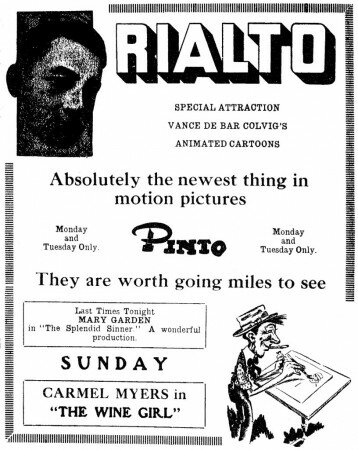
Ben Truwe will illustrate his talk with film clips and photos, and will read an excerpt from Pinto’s unpublished autobiography. Bring your questions – Oregon Cartoon Institute believes in audience Q & A.
More About Goofy: Pinto Colvig, Oregon Animation Pioneer is presented by Portland ASIFA and Oregon Cartoon Institute The evening is free for members of Portland ASIFA and for students. For non-members and non-students, admission is $3.00.
More About Goofy: Pinto Colvig, Oregon Animation Pioneer takes place at 5th Avenue Cinema, 510 SW Hall Street, Portland, Oregon at 7:00 PM on October 12.
On Facebook: https://www.facebook.com/events/234922229992860/
Tags: D. W. Griffith·Don Livingston·Fleischer Brothers·Homer Davenport·Pinto Colvig·Vance DeBar"Pinto" Colvig·Walt Disney·Walter Lantz


